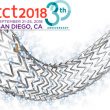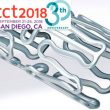1- High-Sensitivity Troponins Turned All Events into Infarctions; the 4th Universal Definition Clarifies Things Myocardial infarction or myocardial injury? The Fourth Universal Definition of Myocardial Infarction (an update of the 2012 version) is here to clarify that not all cases of elevated cardiac troponin values are acute myocardial infarctions. Read more 2- A Simple<a href="https://solaci.org/en/2018/10/09/the-10-most-read-articles-of-september/" title="Read more" >...</a>
TCT 2018 | ABSORB IV: Much Life Left for Bioresorbable Scaffolds
Previous studies have documented higher rates of adverse events with bioresorbable scaffolds (ABSORB) compared with metallic drug-eluting stents (DES). However, these studies included lesions smaller than recommended for these scaffolds and a suboptimal implantation technique. The ABSORB IV study, presented by Dr. Stone at TCT 2018 and published simultaneously in The Lancet, randomized patients to polymeric everolimus-eluting scaffold Absorb<a href="https://solaci.org/en/2018/10/08/tct-2018-absorb-iv-much-life-left-for-bioresorbable-scaffolds/" title="Read more" >...</a>
TCT 2018 | ReCre8 Trial: Permanent Polymer and Zotarolimus vs. Polymer-Free Amphilimus
Polymer-free amphilimus-eluting stents are a novel technology combining sirolimus and long-chained fatty acids. This enhances the uptake of antiproliferative agents and may be associated with lower restenosis, particularly among patients with diabetes. The new device includes abluminal reservoirs filled with the drug; in consequence, there is no need for polymer. This work compares this new<a href="https://solaci.org/en/2018/10/08/tct-2018-recre8-trial-permanent-polymer-and-zotarolimus-vs-polymer-free-amphilimus/" title="Read more" >...</a>
TCT 2018 | MAIN COMPARE: Angioplasty vs. Surgery for Left Main Coronary Artery Disease at 10 Years
Several studies (some of them recent, some of them not so much so) have compared left main coronary artery angioplasty and myocardial revascularization surgery. Combined, these works compose a large corpus of evidence, but follow-up has not gone beyond 5 years in any case. The main aim of this study (presented at TCT 2018 and published simultaneously<a href="https://solaci.org/en/2018/10/08/tct-2018-main-compare-angioplasty-vs-surgery-for-left-main-coronary-artery-disease-at-10-years/" title="Read more" >...</a>
TCT 2018 | BIONYX: Durable Polymer-Coated vs. Ultrathin-Strut, Bioresorbable Polymer-Coated DES
This work, presented at TCT 2018 and published simultaneously in The Lancet, is the first randomized study comparing a zotarolimus-eluting stent with a new thin-strut structure and limited radiographic visibility (Onyx), and a bioresorbable polymer-coated sirolimus-eluting stent (Orsiro). Onyx was developed to improve visibility while reducing strut thickness. To that end, a dense platinum–iridium core and<a href="https://solaci.org/en/2018/10/08/tct-2018-bionyx-durable-polymer-coated-vs-ultrathin-strut-bioresorbable-polymer-coated-des/" title="Read more" >...</a>
TCT 2018 | RESET: Everolimus DES vs. Sirolimus First Generation DES at Long Term
This study had published thrombosis and revascularization rates at one year after stenting, but today one year seems rather short, which is why this cohort was followed up for 5 to 7 years more, to be able to properly assess the differences between first and second generation DES. There were no significant differences a t<a href="https://solaci.org/en/2018/10/05/tct-2018-reset-everolimus-des-vs-sirolimus-first-generation-des-at-long-term/" title="Read more" >...</a>
TCT 2018 | ULTIMATE: IVUS Guided DES Implantation for All Vessels, for All Lesions
Intravascular Ultrasound (IVUS) guided drug eluting stent (DES) implantation is associated with less adverse events compared against angiography guided stenting. This is especially clear for certain populations (with left main PCI as paradigmatic) but not so clear when dealing with all comers. 1448 all comer patients requiring DES stenting were randomized 1:1 to IVUS guided<a href="https://solaci.org/en/2018/10/05/tct-2018-ultimate-ivus-guided-des-implantation-for-all-vessels-for-all-lesions/" title="Read more" >...</a>
TCT 2018 | SYNTAXES: 10 Year Follow Up is ‘Trendy’
The SYNTAX trial had a 5-year follow-up, but the SYNTAXES (“ES” for extended survival) was specifically designed to find out comparative mortality of both treatments (PCI or surgery) at 10 years in patients with three vessel and/or left main lesions. This study retrospectively compared survival data at long term of 897 patients randomized to surgery<a href="https://solaci.org/en/2018/10/05/tct-2018-syntaxes-10-year-follow-up-is-trendy/" title="Read more" >...</a>
TCT 2018 | PREPARE-CALC: Rotational Atherectomy vs. Cutting Balloon in Calcified Lesions
Compared against conventional predilation with balloon, rotational atherectomy is associated with higher procedural success rate in severely classified lesions. Balloons capable of modifying plaque such as the Flextome Cutting Balloon or the AngioSculpt Scoring Balloon -among others- could reach similar results to that of rotational atherectomy, though this has not been tested so far. 200<a href="https://solaci.org/en/2018/10/05/tct-2018-prepare-calc-rotational-atherectomy-vs-cutting-balloon-in-calcified-lesions/" title="Read more" >...</a>
TCT 2018 | TALENT: Ultrathin Struts and Bioresorbable Polymer at the Lowest Possible Cost
This study assessed the Ultra-thin Strut Bioresorbable Polymer-based Coronary DES (Supraflex) against the Xience, with special emphasis in the cost-benefit ratio. It included a population of 1435 all-comers from 23 centers in 7 European countries, randomized 1:1 (720 Supraflex and 715 Xience). Primary end point was a composite of cardiac death, target vessel myocardial<a href="https://solaci.org/en/2018/10/03/tct-2018-talent-ultrathin-struts-and-bioresorbable-polymer-at-the-lowest-possible-cost/" title="Read more" >...</a>









